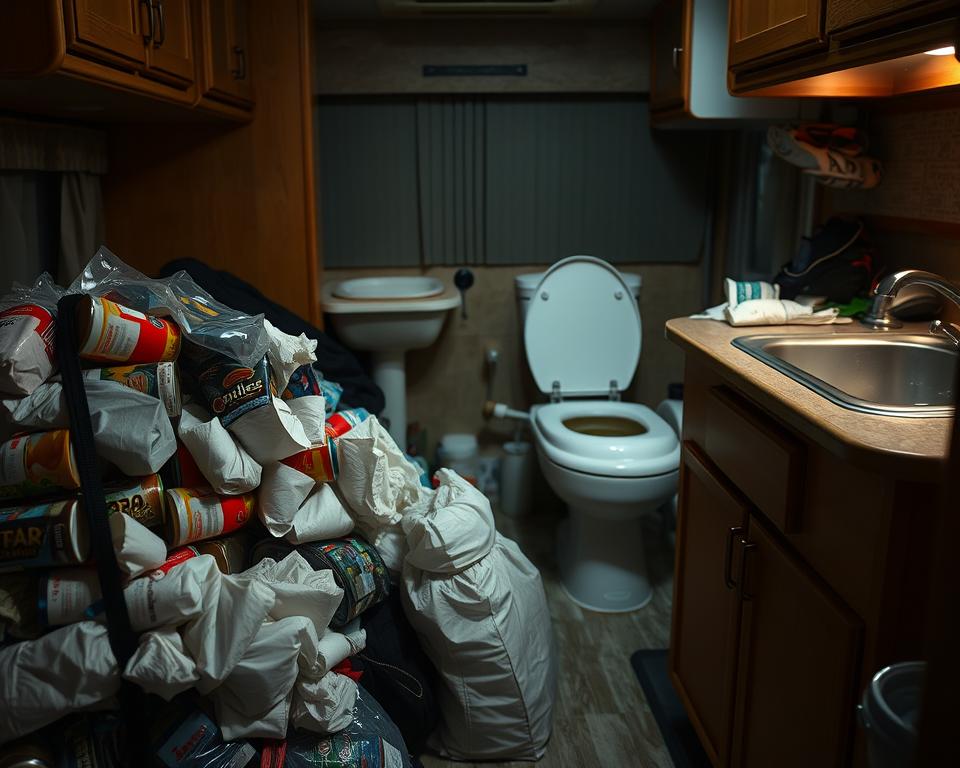Recreational Vehicle Sewage Pump Handbook: Essential Tips for Maintenance
Have you given thought to the operation of your camper’s waste disposal system? Knowing the details of your RV sewer pump can prevent mishaps, improving your outdoor adventures. It’s about managing waste effectively and dodging foul smells. Through this guide, you’ll discover essential maintenance tips for RV septic service near me. All are crafted to sustain your sewage system’s optimal function.
Grasping Your RV Sewer Pump System
The RV sewer pump system is vital for sewage control, making RV outings more comfortable. It includes two principal tanks: the black water tank for solid waste and the sink/shower runoff tank for water from sinks and showers. Differentiating these tanks is important to ward off clogs and keep your RV operating smoothly.
An RV macerator pump is a widely used solution for refuse disposal. It shreds solid waste into minute particles, streamlining disposal. As another option, a classic RV pump is available. It efficiently moves waste without shredding, for those choosing a simpler option.
Understanding your RV’s sewage pumping system is key to avoiding problems and ensuring smooth examinations. Operating the system correctly can prevent messes, improving your outdoor adventures.
Importance of Regular Maintenance
Maintaining your RV waste pump is vital for a seamless trip. Without proper servicing, you may encounter odors, clogs, or backups. These issues can wreck your road trips.
Consistent servicing avoid such problems and extend your system’s life. By inspecting hoses and seals, you boost efficiency. A well-serviced RV sewage pump guarantees clean waste handling, letting you enjoy nonstop trips.
Frequent upkeep also results in financial savings over time. Disregard can cause significant problems, requiring cost-intensive maintenance. Putting resources into regular maintenance keeps your motorhome in top condition, saving money long term.
Recommended Frequency for RV Septic Tank Pumping
Understanding when to empty your RV Septic tank is vital for its upkeep. It’s best practice to pump every 72–120 hours during use. For brief excursions, post-trip emptying may work fine.
Interval depends on various elements. Tank capacity and usage level are key. Ideally pump when it reaches two-thirds full. This helps support smooth flow and ward off clogs.
Checking your RV Septic tank levels is essential for a smooth journey. Oversee properly your camper’s refuse to avoid issues while traveling.

Top Techniques for Tank Drainage
Correctly draining RV tanks is crucial for your motorhome’s hygiene and operation. Always empty first the black tank to let the grey tank liquid rinse leftover solids. This technique stops clogs and ensures smooth operation.
Pick a high-quality waste hose for disposal. A robust hose ward off leaks and fastens connections. Attach a tank rinser for a deep clean, using water pressure to remove residual sludge, upgrading cleanliness.
Thorough draining prevents residue buildup, stopping foul odors and potential issues. To maintain an optimal sewage system in your motorhome, follow these guidelines:
- Consistently apply a tank additive post-drain to control odors and break down waste.
- Keep an eye on fill levels to avoid leaks.
- Check your RV sewer pump often for clogs and wear.
- Perform a deep tank flush every 4–8 weeks, even during less frequent trips.
Implementing these practices enhances your sewage system’s lifespan and efficiency, ensuring smooth journeys.
Preventing Odors and Clogs
For a enjoyable trip, avoiding stench is key. Ensure tanks have sufficient water to aid in waste breakdown, avoiding unpleasant odors. Also, opting for RV-approved tissue helps prevent clogs, ensuring uninterrupted operation.
For improved waste handling in campers, try enzyme-based tank treatments. These process sludge thoroughly, reducing effort. Regularly inspect the vent pipe to keep air moving freely in the plumbing system.
Cautious flushing is key to avoiding tank issues. Do not flush wipes, feminine products, and paper towels. These non-biodegradable items can cause serious blockages. Adhering to these guidelines helps maintain a tidier camping environment.
Care Recommendations for RV Waste Pumps
Caring for your camper’s waste pump setup is key for trouble-free travels. Inspect dump valve seals regularly to stop seepage. Faulty seals can cause accidents, harming your RV.
To eradicate odors and maintain cleanliness, sanitizing is key. Perform a deep clean every few months to curb scale formation, ensuring the system operates smoothly. These steps are necessary for maintaining a portable RV pump, promoting extended service and efficient operation.
Oiling valve mechanisms is another crucial task. It helps ward off seepage and improve functionality. Checking sensor accuracy is vital for precise measurements, preventing spillovers and unexpected pump issues. Staying on top of these checks makes your RV adventures cleaner and more enjoyable.
Clues for Hiring a Professional Pump Service
Spotting sewage issues early can ward off major issues. A primary clue you need a pro pump service is sluggish flow. When sinks and toilets take longer to clear, it often points to obstructions. It suggests your system may be backed up.
Persistent odors are another clear sign of sewage troubles. Unpleasant fumes hanging around despite cleaning suggest trapped waste. It’s crucial to check the transparent elbow fitting when dumping waste. Visible residue signals it’s time for professional pump service.
Technicians employ water-jet systems to dismantle stubborn blockages efficiently. Ignoring these warnings can snowball major problems. Therefore, it’s critical to seek help immediately when issues arise.
| Warning Signs of Waste Problems | Suggested Steps |
|---|---|
| Slow Draining | Check obstructions; call expert service |
| Ongoing Foul Scents | Inspect fittings; schedule pump-out |
| Remaining Sludge | Call pro for deep cleanse |
Deciding on the Best RV Macerator Unit
When evaluating an RV macerator pump, evaluate its capacity, durability, and compatibility with your RV’s size. A top-notch macerator is essential for smooth sludge processing. This is especially vital for RVs requiring regular emptying. High-end pumps enhance sewage handling, ensuring a smoother RV lifestyle.
Multiple designs cater to specific demands. For an educated choice, focus on these key factors:
- Capacity: Ensure the pump can handle your RV’s waste output.
- Durability: Select long-lasting equipment.
- Ease of Use: Look for user-friendly pumps.
- Compatibility: Verify the pump fits your RV plumbing.
Taking time to compare when choosing an RV macerator pump improves travel enjoyment and ensures proper sewage disposal.
RV Sewer Pump Problem-Solving
Accurate diagnosis for your RV sewer pump is vital in rectifying common sewage issues before they worsen. If you notice slow drainage, unplanned backflows, or persistent odors, act quickly. These are obvious indicators of malfunction requiring attention.
Begin by examining the pump, its connections, and hoses. Look for any clogs that could slow flow. Ensure inlet and outlet fittings are properly connected. Also, verify the pump’s power supply for proper voltage.
If basic checks don’t detect the issue, listen to the pump’s sound. A unit that’s overly noisy or unusually silent may have internal damage. Also, inspect for leaks, as these can exacerbate sewage problems. With these troubleshooting steps, many RV owners can find and fix issues early, avoiding costly repairs.
Long-Term RV Sewer Pump Care
For continued reliability, commit to regular sewer pump upkeep. Sanitize the system consistently to prevent clogs. Implement and follow a maintenance routine, keeping everyone informed of their roles. This considerably extends your waste system’s lifespan.
Training yourself and others on correct flushing habits is essential. This avoidss issues and fosters shared responsibility. The result benefits both users and the sewer system.
- Routine inspection of hoses and connections
- Maintain clear filter screens
- Book expert service once a year
- Select suitable additives
Following these guidelines prolongs your camper’s sewage system’s durability and keeps it effective, making travels more pleasant.
Final Thoughts
Keeping your RV sewer pump in prime condition is vital for smooth camping adventures. Regular attention to RV sewer system maintenance greatly minimizes problem risks, letting you focus in the journey. By understanding your system and using reliable sewage methods, your trips will be free of waste management woes.
Applying the vital tips from this guide improves RV waste management and advances your travel comfort and safety. Maintain peak performance by following best upkeep practices and addressing potential issues promptly.
Keeping informed about your RV sewer system yields benefits. It ensures homely comforts while exploring. Here’s to joyous and untroubled journeys!
FAQ
How can I tell it’s time to empty my RV Septic tank?
Pump the RV Septic tank when it hits 66% capacity.
How do black and grey tanks differ?
Black tank is for sewage waste. Whereas, the grey tank collects water from basins and showers.
When to service my RV sewer pump?
Check seals, sanitize, and clean quarterly.
Recommended products for RV sewer pump maintenance?
Choose RV-approved enzyme formulas and quality hoses and rinsers.
How do I avoid clogs in my RV sewer system?
Use only RV-safe toilet paper.
How to know if I need expert pump-out?
Persistent smells or gurgling indicate pro help.
How can I improve my RV macerator pump’s efficiency?
Choose a robust model and follow manufacturer guidelines.
What should I check during a deep clean of my RV sewer system?
Inspect all connections and hoses.
Maintaining my RV sewer system over time?
Adopt regular deep cleans and consistent sanitation.
How often should I empty my RV Septic tank with regular use?
Schedule pump-outs every 3–5 days.
